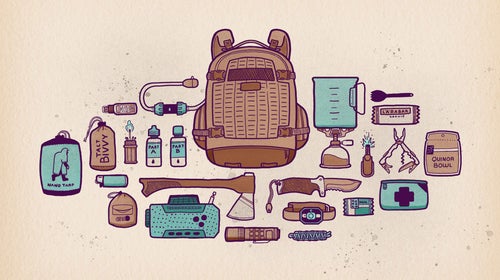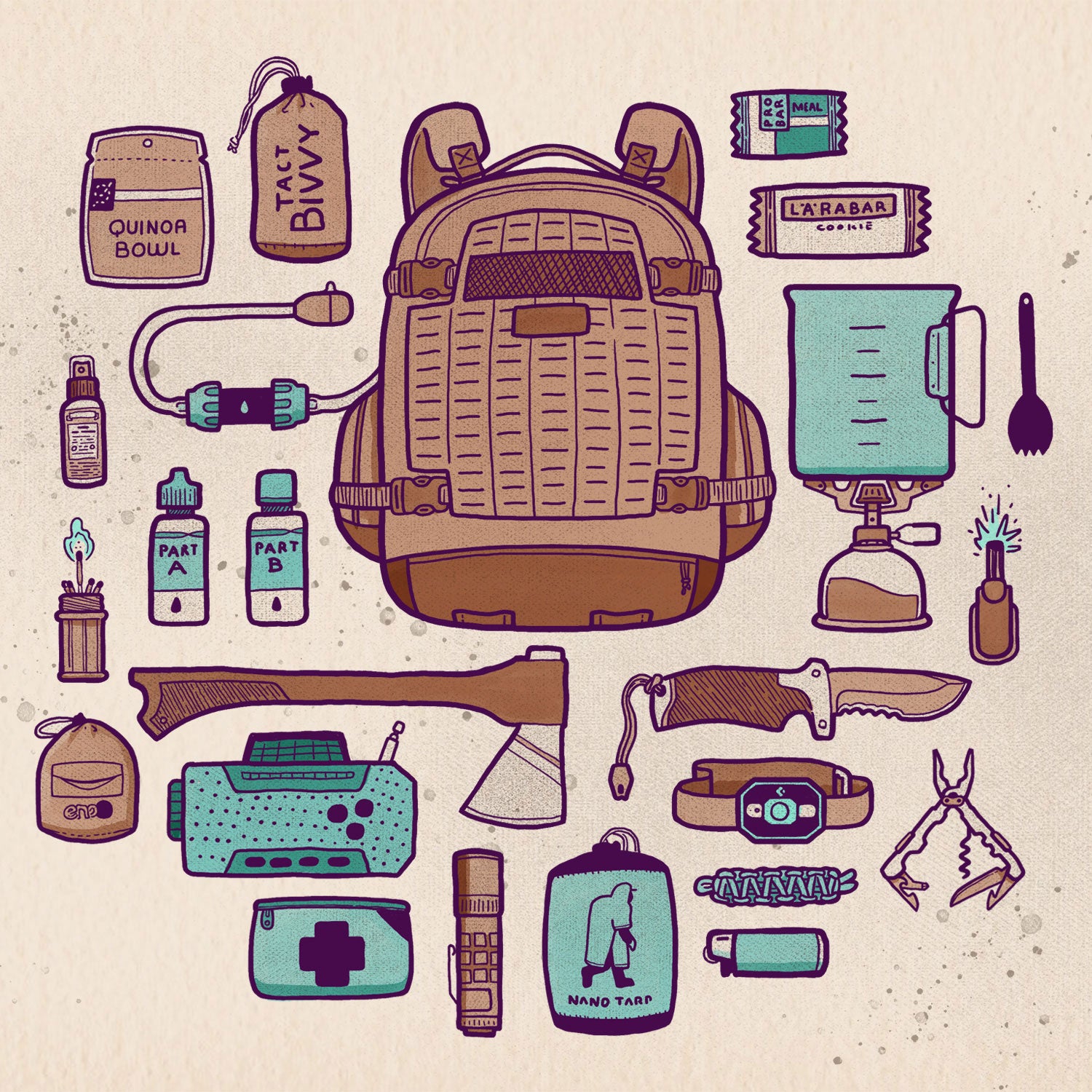From certain angles, it looks like we’re hanging over the precipice. Climate change–fueled disasters like monster hurricanes, megafires, and 100-year droughts are becoming ever more frequent. A solar superstorm could , the New Madrid fault might go at any moment, and, of course, there’s always potential for a .
Sure, some of those scenarios are more likely than others, but companies like �����Ի� are cashing in on the fear with affordable ready-made bug-out kits packed with survival essentials that start around $300. Containing dehydrated food, water treatment supplies, emergency blankets, and other fundamentals, they’re a great starting point, but each misses a few important items, such as a water bottle, shelter, or stove.
We decided to start from scratch and see what the ultimate survival kit would look like. Turns out, it’s lighter, smarter, more versatile, and, at just around $1,200, a whole lot more expensive. But with your life literally on the line, these high-performance essentials will help see you through the first 72 hours—the time it takes to survive most disasters.
The Bag
A backpacking rig will work, but a light, versatile bag tailored to grab-and-go situations is best. That’s why we love military-style tactical packs like the ($383). This low-profile bag features composite webbing on the harness and front panel so you can customize your load simply by sliding on extra pouches like those . The three-liter, military-spec lumbar reservoir stabilizes water weight right on your hips to lower your center of gravity, and the zip on the back panel means you don’t have shift your gear around to load or refill on the go.
Hydration
You won’t be able to rely on finding clean water—keep your reservoir full so you’re ready to go at a moment’s notice. Make sure to change the water every season, though, and pack at least two methods of purification. Aquamira’s ($15) treat 30 gallons at once. The ultralight ($25) can be used like a straw to sip directly from puddles, or you can pair it with your hydration tube for inline filtration when you don’t have time for chemical treatment.
Food
Good-to-Go’s dehydrated ($7) packs 700 calories, lasts two years, and weighs just six ounces. You’ll also want a handful of calorie-dense bars, like Larabar’s two-ingredient ($16 for 13) or the ($44 for 12). Stow enough of both to last at least three days.
Cookware
Keep cooking minimal and fuss-free with a unified ultralight system. Pair the 24-ounce pot ($45) with its ��($60), ($10), and 110-gram ($5), which is good for about five days of meals. All are built from feathery titanium, so you’ll hardly notice them in your pack.
Clothing
You’ll probably have to make do with just the clothes on your back, but be sure to pack Sea to Summit’s eight-ounce ($100), which fits over your pack and doubles as a two-person tarp shelter.
Shelter
Sacrifice the comfort of a tent for mobility by pairing your tarp poncho with a foam pad, such as Gossamer Gear’s sub-three-ounce ($18) and ($25). Or get off the ground with Eno’s ($50) and ($30).
Fire
Pack three kinds of fire starters: a ($7 for five), ($8), and ($13). For tinder, stuff petroleum jelly–soaked cotton balls into a couple of film canisters.
First Aid
Start with the ($41), which contains all the essentials, like four feet of duct tape, then top it off with whatever suits your personal needs, including a stash of prescription medication.
Hygiene
Keep it simple with ��($5), ($9), ($3), and an ultralight ��($10).
Tools
($60) is a fixed-blade survival knife that boasts a ferrocerium fire-starter rod, emergency whistle, steel pommel that doubles as a hammer, and a diamond sharpener. ($60) sports 17 tools and weighs just 4.6 ounces. Finally, a hatchet might sound like overkill, but Gary Paulsen taught us just how useful they can be. ($43) is lightweight and hides a handsaw in the handle. Go ahead and toss in a length of ($5) for good measure, and learn a few knots.
Lighting
Go hands-free with the ($50), which has 350 lumens and lasts 40 hours on high or up to 120 hours on low. For backup, Maglite’s compact ($56) throws 310 lumens a whopping 600 feet, has a power saving mode, and clips onto your belt. Don’t forget extra batteries.
Communication
Stay informed with ($33), which receives AM/FM stations and NOAA weather alerts and includes a built-in flashlight, solar panel, SOS alarm, and a micro-USB port to charge your phone and other devices.


